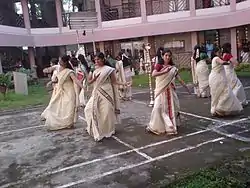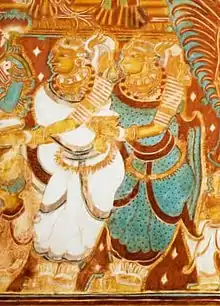Kerala sari
Kerala sari (Set-sari) (Malayalam: കേരള സാരി) is a clothing of women in the Indian state of Kerala.

Mundum Neriyathum

It is worn as a garment that closely resembles the mundum neriyathum though it is not considered a true mundum neriyathum by classic definition. This is because the Kerala sari[1] consists of a single piece of cloth while a traditional mundum neriyathum consists of a two-piece cloth. Otherwise, the Kerala sari closely resembles the mundum neriyathum and is often worn by Malayali women as a quasi mundum neriyathum.
This one-piece sari in Kerala is derived from neighboring Tamil Nadu or Deccan during medieval period based on its appearance on various temple murals in medieval northern Kerala, modified by combining two-pieces of traditional Mundu in Kerala.[2][3][4]
Cultural costume

Kerala sari is regarded as the cultural costume of women of the Malayali community.[3] The grace and appeal of the golden borders contrasting with the otherwise plain white mundum neryathum of Keralite women has come to symbolize Malayali women. The sari is a hot favorite during the time of Onam, not just in Kerala but in other parts of India as well. [5]
In popular culture
Both the traditional and modern styles of the mundum neryathum are depicted in the paintings of the Indian painter Raja Ravi Varma. The mundum neriyathum was modified in several paintings depicting shakuntala from the mahabharatha to a style of draping now popularly known as the 'nivi saree' or 'national drape'. In one of his paintings, the Indian subcontinent was shown as a mother wearing a flowing nivi saree.[6]
See also
Notes
- "Kerala Saree". external.
- Wall paintings in North Kerala, India: 1000 years of temple art, Albrecht Frenz, Ke. Ke Mārār, page 93
- Boulanger 1997, Ghurye 1951
- Miller, Daniel & Banerjee, Mukulika; (2004) "The Sari", Lustre press / Roli books
- "Say it in gold and off-white". The Hindu. Kochi, India. 14 September 2016.
- Miller & Banerjee 2004
References and bibliography
- Boulanger, C (1997) Saris: An Illustrated Guide to the Indian Art of Draping, Shakti Press International, New York. ISBN 0-9661496-1-0
- Mohapatra, R. P. (1992) Fashion styles of ancient India, B. R. Publishing corporation, ISBN 81-7018-723-0
- Alkazi, Roshan (1983) "Ancient Indian costume", Art Heritage
- Mahaparinibbanasutta (ancient Buddhist text)
- Miller, Daniel & Banerjee, Mukulika; (2004) The Sari, Lustre press / Roli books
- Bjorn Landstrom (1964) The Quest for India, Doubleday English edition, Stockholm.
- T.K Velu Pillai, (1940) "The Travancore State Manual"; 4 volumes; Trivandrum
- Miller, J. Innes. (1969). The Spice Trade of The Roman Empire: 29 B.C. to A.D. 641. Oxford University Press. Special edition for Sandpiper Books. 1998. ISBN 0-19-814264-1.
- K.V. Krishna Iyer (1971) "Kerala’s Relations with the Outside World," pp. 70, 71 in The Cochin Synagogue Quatercentenary Celebrations Commemoration Volume, Kerala History Association, Cochin.
- Periplus Maris Erythraei, The Periplus of the Erythraean Sea, (trans). Wilfred Schoff (1912), reprinted South Asia Books 1995 ISBN 81-215-0699-9